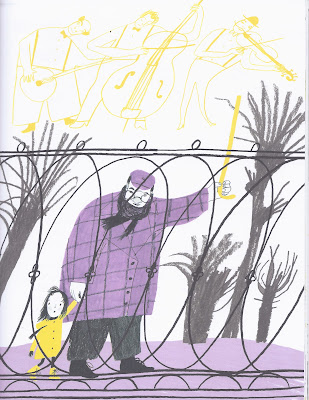Thanks to the blog World Kid Lit and their #WorldKidLitMonth each September, I discovered a wonderful new chapter book, The Invisible Elephant, written by Anna Anisimova, illustrated by Yulia Sidneva, and translated from the Russian by Ruth Ahmedzai Kemp.
I love many things about this book. To name a few:
- The way its art is beautifully integrated with the text, with illustrations on every spread and indeed, in some form, on every page.
- Its muted colors, selective palette, and design that appears simplistic at first glance but is in fact highly thoughtful, creative, and supportive of the story.
- The short, one-to-two page chapters, consistently expressed in the young girl’s voice.
- The narrative arc as the story develops over four sections, each portraying the main character’s growing understanding of the world around her.
Most of all, I love the little girl and the family who nurtures her. Gradually we learn that for her, seeing is touching. In the title story, “The Invisible Elephant,” she says: “But I really want to see this elephant. Where is it? I’ve never felt one before.”
Throughout the stories, the verb “see” is used in the same way a sighted person would, except her seeing involves using her other senses. How does this work? One example is when Mama describes the color choices for a new coat they are buying; red is equated to tomatoes; green to apples. Our girl chooses “…the apple coat! Because apples make a lovely crunch when you bite them, and tomatoes are squashy and squelchy.”
The illustrations are playful and energetic, like the main character herself. As in the art, where the use of white space allows the viewer’s imagination to enter more fully into the experience, this girl’s lack of visual definition stimulates an imagination rich in ideas, connections, and perceptions. And humor.
The second story, “Speedy,” features Grandpa coming to live with them — and Grandpa has three legs! The third being his walking stick, which they name “Speedy” and use to devise numerous games, often involving sound. When something unexpected happens, our girl decides she, too, needs a walking stick and begins to learn how to use it.
In the third story, “The Music of My Woodpecker,” the girl begins to learn about reading. At the library she discovers tactile books and is introduced to Braille. She calls her stylus for punching Braille dots “Woodpecker.” At first she resists learning what the “bubbles” mean — after all, it’s much easier to just listen and be read to — but when her friend Pasha is intrigued by this “secret code,” she begins to enjoy a new way to communicate.
The fourth story, “Whale Seeks a Friend,” involves not just an imaginary friend, Whale, but a real one she meets while sledding. When she bumps up against a baffling (to her) negative stereotype, her father marvelously turns the experience into an affirming one.
Throughout the book, the reader is gently nudged to check their own assumptions — not overtly, but through entering into this lovely child’s imagination and life, with all its joys, challenges, and richness.
Published by Yonder, an imprint of Restless Books, New York, 2023.






No comments:
Post a Comment